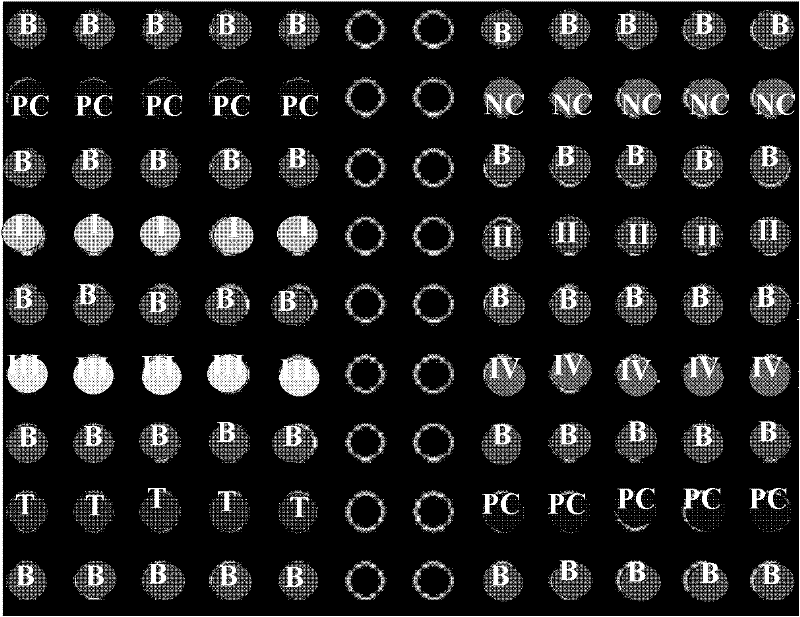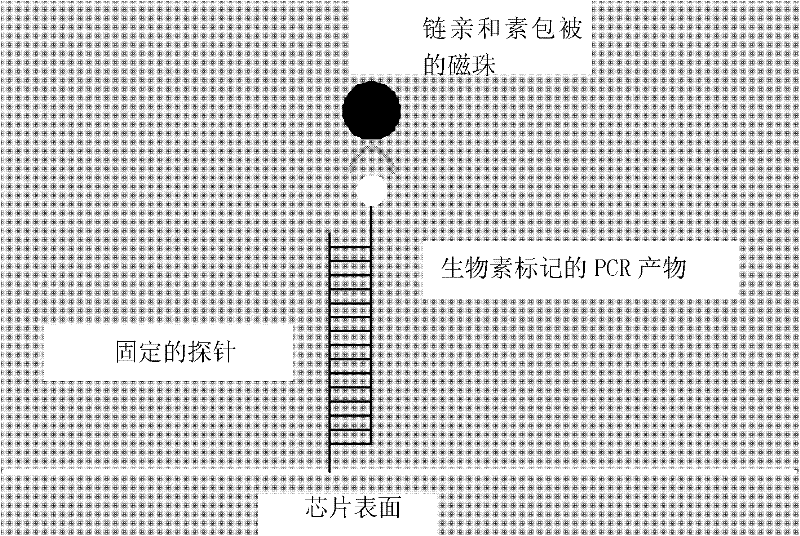Method for detection and typing of dengue virus, special chip and kit
A dengue virus and kit technology, applied in biochemical equipment and methods, microbial determination/inspection, resistance to vector-borne diseases, etc., can solve the problems of long time and complicated operation, and achieve low cost and good specificity. Effect
- Summary
- Abstract
- Description
- Claims
- Application Information
AI Technical Summary
Problems solved by technology
Method used
Image
Examples
Embodiment 1
[0063] Embodiment 1, the structure of biochip and its preparation
[0064] 1. The structure of the biochip
[0065] 1. The biochip is composed of a biochip base and detection probes connected thereto, positive quality control probes (PC), negative quality control probes (NC) and magnetic labels;
[0066] 2. The detection probes are shown in 1) and 2) below:
[0067] 1) a universal probe for detecting dengue virus, the core hybridization sequence of which is shown in SEQ ID NO: 5;
[0068] 2) There are four types as follows:
[0069] 2)-1. The probe for detecting type I dengue virus, its core hybridization sequence is shown in SEQ ID NO: 1,
[0070] 2)-2. The probe for detecting type II dengue virus, its core hybridization sequence is shown in SEQ ID NO: 2,
[0071] 2)-3. The probe used to detect type III dengue virus, its core hybridization sequence is shown in SEQ ID NO: 3,
[0072] 2)-4. The probe for detecting type IV dengue virus, the core hybridization sequence of wh...
Embodiment 2
[0116] Embodiment 2, the kit for detecting dengue virus serotype
[0117] 1. The composition of the kit is as follows:
[0118] 1. The biochip in Example 1.
[0119] 2. The primer pair composition of the target band in the amplified sample, as shown in I to V:
[0120] I. A pair of primers shown in SEQ ID NO: 8 and SEQ ID NO: 9; the amplified product of the primer pair I type dengue virus can hybridize with the probe DEN-1.
[0121] II. A pair of primers shown in SEQ ID NO: 10 and SEQ ID NO: 11; the amplified product of the primer pair of type II dengue virus can hybridize with the probe DEN-2.
[0122] III. A primer pair shown in SEQ ID NO: 12 and SEQ ID NO: 13; the amplified product of the primer pair III dengue virus can hybridize with the probe DEN-3.
[0123] IV. A primer pair shown in SEQ ID NO: 14 and SEQ ID NO: 15; the amplification product of the primer pair IV dengue virus can hybridize with the probe DEN-4.
[0124] V, a pair of primers shown in SEQ ID NO: 6 and...
Embodiment 3
[0136] Embodiment 3, the application of kit
[0137]Type I dengue virus positive samples: Serum samples from people infected with type I dengue virus but not infected with other types of dengue virus, taken from the Shenzhen Center for Disease Control and Prevention, all with the consent of the patient; identification methods see: KRGurukumar, D Priyadarshini, JA Patil, A Bhagat, A Singh. Development of real time PCR for detection and quantitation of Dengue Viruses. Virology Journal, 2009, 1, 23: 1-8).
[0138] Type II dengue virus positive samples: Serum samples from people infected with type II dengue virus but not infected with other types of viruses, obtained from the Guangdong Provincial Center for Disease Control and Prevention, with the consent of the patients; for identification methods see: KR Gurukumar, D Priyadarshini, JA Patil, A Bhagat, A Singh. Development of real time PCR for detection and quantitation of Dengue Viruses. Virology Journal, 2009, 1, 23: 1-8).
[...
PUM
 Login to View More
Login to View More Abstract
Description
Claims
Application Information
 Login to View More
Login to View More - R&D
- Intellectual Property
- Life Sciences
- Materials
- Tech Scout
- Unparalleled Data Quality
- Higher Quality Content
- 60% Fewer Hallucinations
Browse by: Latest US Patents, China's latest patents, Technical Efficacy Thesaurus, Application Domain, Technology Topic, Popular Technical Reports.
© 2025 PatSnap. All rights reserved.Legal|Privacy policy|Modern Slavery Act Transparency Statement|Sitemap|About US| Contact US: help@patsnap.com



